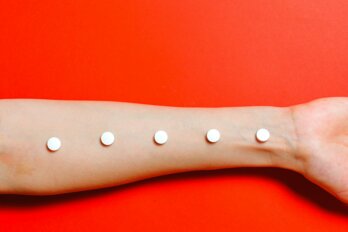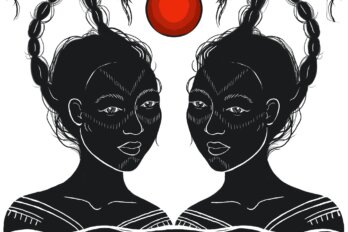The interview room felt clinical—sanitized, even. The walls were the kind of white that made my heavily melanated skin seem ten shades deeper. I was always acutely aware of my Blackness in academic spaces, where people who looked like me were scarce. This moment was no different.
An empty chair sat tucked under an expansive grey table, across from an older white gentleman with thinly framed glasses and a crisp button-up shirt. The doctor stood when I entered, and he extended his hand; he was exceptionally tall and wore a cheerful grin. In almost military fashion, I stretched my hand to his for a firm, professional handshake.
“Hi, I’m Chika!” I said, willing myself to ignore the sound of my heart pulsing in my ears. His handshake was surprisingly warmer and softer than I’d expected. He returned to his seat as I pulled out the chair.
“Hi there, I’m Dr. Galloway, an academic cardiologist at University Health Network. I’ll be your interviewer for this station,” he said. His eyes were a coral blue that seemed to have the ability to detect any insincerity.
Executing an interview to get into medical school is a calculated science of sorts. You need to come polished and rehearsed but not sound robotic and inorganic. Your hand gestures need to be well placed and frequent enough to demonstrate personality and interest without becoming distracting or appearing frantic. Your answers to the interviewer’s questions need to be detailed yet sufficiently brief to leave space for further questions, or you run the risk of appearing disorganized. You need to present the best version of yourself, not only in how you speak but also in how you look.
I tucked a loose lock of hair behind my left ear, then quickly placed my hands on the table and tightened my smile, ready for his first question. The singular twist swiftly sprang back out, almost in retaliation, as though it was demanding to be seen.
My natural hair was styled in mini twists that landed just above my shoulders. They had taken me approximately five hours to style the night before, following the painstaking process of detangling, moisturizing, and parting through my freshly washed Afro, which, in its unmanipulated state, grew outward and not downward. I had taken extra care in smoothing my edges down with gel, sweeping the coily baby hairs into one of the tight twists and hiding the kinky, wild texture that was historically seen as unkempt and unprofessional.
By morning, my edges had already started to kink in defiance. I dug out a jar of Eco Styler gel and an old toothbrush, flattened the fraying hairs, and begged them to behave for once. I believed then, through both a visceral understanding and explicit warnings from others, that wearing my hair in its most natural state would not meet the standards of presentability in a medical school interview. There was not enough room for my Afro to sprawl in the halls of the ivory tower, and so it needed to be hidden away.
“Why don’t you straighten your hair?” my mother had asked a week prior to the interview. I combed my fingers through the densely knotted curls and tried to tease them apart. I shook my head. I didn’t want to incur heat damage on the tresses I had so carefully nurtured over the past three years. Silk presses—a style in which Afro-textured hair is blow-dried, parted into small sections, and pressed with a flat iron—represent the versatility of natural hair and Black beauty. But doing them with too much heat or too frequently can lead to the destruction of one’s natural hair pattern, leaving one with curls that don’t revert on wash day. Every naturalista’s nightmare. I had invested too many evenings in watching YouTube tutorials by natural-hair gurus on how to achieve waist-length 4C hair—my type, according to the Andre Walker Hair Typing System—to wash away my progress.
“I don’t think so, Mommy. I have a better idea,” I said, pulling a loose curl taut and watching it spring back into its firmly wound position. I determined that mini twists would be the perfect middle ground; my hair would retain its natural curls while being styled in a way that would come across as less imposing. I promised my coils, as I twisted them into singlets the evening before the interview, that if I got in, I would embrace them once more. A small and temporary sacrifice of identity—or so it seemed.
As I entered the Michener Institute that fateful January morning, I realized that I was the only Black medical school interviewee in a crowd of dozens. I wondered whether the other candidates shared the burden of combating their natural features. I questioned if they could feel the weight of their skin, heavy and conspicuous in its obvious hue and difference. I wondered if they even noticed that I was the only Black candidate and if they questioned how this could be possible at an interview in Toronto, one of the most ethnically diverse cities in the world.
Sitting across from the older white male cardiologist, I wondered if he was questioning whether I fit the mould of what a physician really looks like.
Dr. Galloway flipped through the first couple of pages of my CV and landed on the section about my extracurricular activities during university. His index finger slid down the page before landing on the second last line, and he tapped on a bolded section.
“I see you did some research in adolescent maternity and mental health. Tell me more about this,” he said. I explained how my lived experience with my sister’s teen pregnancy had inspired me to explore the unique challenges faced by teenage mothers and their children and how to address them. He nodded, seemingly pleased with my answer. I felt my muscles soften and my pulse slow. I can do this, I thought to myself.
We spent the next five minutes combing through my résumé, dissecting areas of my past that piqued his interest. He inquired about my stint as a barista at Starbucks for a year and a half and joked about how dealing with a pre-caffeinated lawyer at the crack of dawn was the best preparation for bedside medicine. I chuckled agreeably, withholding the darker stories of me crying in defeat while mopping the floors and scrubbing the toilets at work after my first round of medical school interview rejections the year prior. I remembered standing in the bathroom, staring at my puffy red eyes in the mirror, green apron stained with tears, and praying for this exact moment. I knew that the interview would be where I would shine; if I could just land one, I knew I had a good shot at getting in.
Our time together was waning, and in a matter of minutes, I had the opportunity to gush about my experience as a slam poetry coach at Westdale Secondary School, where I led a group of novice poets to become regional slam poetry champions. I explained how I taught them to use poetry as a platform for self-expression and socio-political activism, transforming them from shy, uncertain teenagers into confident, boisterous performers. One of my favourite poets on the team, I recalled, was a teenager who was neurodivergent. They were reserved and rarely spoke during our after-school practices, but when they shared their poetry, our group was dazzled.
Dr. Galloway studied me closely as I spoke, peering at me over the rim of his glasses, smiling gently. He continued to flip through the pages, looking at pre-circled headings and scribbles in the margins.
“Canadian Slam Poetry national finalist?” he said as he skimmed through the awards and accolades section. I smiled and nodded. “Yes, I just competed in my second national spoken-word competition this past October in Saskatoon. My team and I placed second in the country.”
“Ah! So, I’m in the company of a nationally ranked poet? Well, isn’t that different!” he said, eyes widening. “Why don’t you perform some poetry for me? Maybe one of the pieces you shared at nationals?”
Time seemed to slow to a grinding halt, and the air became denser, hotter. Perform? I thought to myself. I had not prepared for this.
“Sure, of course!” I replied. I knew that declining his request could demonstrate a lack of confidence in myself and my abilities, casting doubt over my synergy with medicine—a field that invariably requires doctors to act quickly under pressure.
I slowed my breathing as I scanned a mental catalogue of my poetry. What about “SKIN”? I thought to myself. It had been several months since I’d rehearsed and performed this piece, which was a deep examination of racial politics and police brutality against unarmed Black civilians. It would be a powerful performance, I knew, but one that would also magnify the gap between me and my interviewer—a young Black politically charged woman appealing to the ethos of an older white male physician whose political leanings were unknown to me. Would it be worth the risk?
“SKIN,” my favourite of all the poems I have ever written and performed, was composed in my fourth year of university for a creative writing assignment in a course on leadership and effective professional communication. Our professor was a brilliant industrial and organizational psychologist who assigned us the task of creating a captivating piece that would serve as a call to action. Fresh off the heels of the 2014 murder of Mike Brown in Missouri, which was a heinous abuse of police force and a case of racially targeted violence, I was galvanized to write a poem about what it felt like to be Black. To be targeted. To live in perpetual fear of white violence and silence. Although the experiences and historical context of Black Canadians differ from those of Black Americans, we are often connected in our experiences of being marginalized, subjugated, and brutalized through systemic racism. I knew I had to speak up.
I wrote the poem, start to finish, in a matter of hours. I memorized it—gestures, cadence, speed, and tonality—within a day. I stood at the front of my class, boldly, bravely. Black. The only Black person in the room.
I wanted the audience to feel something—a visceral discomfort, the deep unease of the pain that comes with the Black experience. Beyond this, however, I wanted my classmates to deeply question what it felt like for me, as the only Black person in our year, to navigate the halls of the prestigious—and often othering—Health Sciences building. Would they leave the performance and recall the time when another student had asked me during our anatomy lesson, in front of classmates, why Black people loved fried chicken and if the reason was related to slavery? Would they have felt the same smouldering embarrassment I did as our classmate chuckled and turned away? I wondered if they would have remorse about the health sciences Halloween party of 2013, when one of my classmates came painted in Blackface, with a fake gun, fake marijuana blunt, chest-length dreads, and costume cup of “purple drink.” Would they feel the need to atone, given how many people had openly encouraged the classmate in the days leading up to the party, while I confronted them about the inappropriateness of the idea? I wondered if one student would be eating his words after telling me that “it’s not that big of a deal” and I should “get over it.”
To be Black in my undergraduate program was to be painfully discernible and erased in the same moment. “SKIN” is a cathartic release, an in-your-face, no-looking-away exploration of racism, police brutality, Black trauma, and non-Black apathy. It challenges the listener to step into Black skin, stand in the scope of the white gaze and public inaction, and question how they could change their behaviour, or at least their subconscious thoughts, to be a better ally.
As I took this poem from the classroom to the regional stage at the Hamilton Youth Poetry Slam, it became known as my most evocative, gut-wrenching, beautiful piece of poetry. It was written to make people uncomfortable, since change rarely happens in spaces of comfort. It was written to make people think. People like Dr. Galloway.
I decided to perform “SKIN” during the interview. Not because I was certain it would earn me a spot in the 2016 matriculating class at University of Toronto medicine but because it was the clearest path into my humanity as a Black woman.
Dr. Galloway leaned against the table and folded his arms in anticipation. His head was slightly tilted, his eyes focused on me.
Every poet has their rituals before a performance. Some artists will get to the stage and warm up the crowd with silly banter and pleasantries. Others will silently take the mic, pause, and dive, head first, into their first stanza. I fall somewhere in between.
I smiled at Dr. Galloway before closing my eyes and drawing a slow, deep breath. As I’d done hundreds of times before a performance, I interlocked my fingers, clasping my hands on my lap and mildly flexing my thumbs. I let my shoulders relax, slowly lengthening my neck, and bringing my chin upward and opening my eyes.
I pulled the first line of my poem from my mental catalogue and set off.
Excerpted from Unlike the Rest: A Doctor’s Story by Chika Stacy Oriuwa, 2024. Published by HarperCollins Canada.






